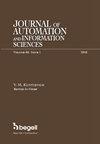EXPLICIT DISTRIBUTION OF SELECTED TWO-DIMENSIONAL AND THREE-DIMENSIONAL STATISTICS OF THE (0,1)-SEQUENCE
Q3 Engineering
Journal of Automation and Information Sciences
Pub Date : 2021-09-01
DOI:10.34229/1028-0979-2021-5-6
引用次数: 0
Abstract
The joint distributions of the given number of 2-chains and the given number of 3-chains of a fixed form of a random bit sequence are considered, which allow performing a statistical analysis of local sections of this sequence. All configurations consisting of two consecutive zeros or ones of a bit sequence of a given length act as 2-chains. In turn, 3-chains are all configurations consisting of three consecutive either ones (provided that the 2-chains are zero) or zeros (provided that the 2-chains are one), as well as 3-chains all configurations are considered that consist either of three consecutive digits: one, zero and one (provided that the 2- chains are zero), or of three consecutive digits: zero, one and zero (provided that the 2- chains are one). The paper establishes explicit expressions for two-dimensional and three-dimensional joint distributions of events, reflecting the number of some combinations of the indicated chains in a finite random bit sequence. One of the basic assumptions is that zeros and ones in a bit sequence are independent, equally distributed random variables. The proofs of the formulas for the distributions of these events are based on counting the number of corresponding favorable events, provided that the bit sequence contains a fixed number of zeros and ones. As examples of using explicit expressions of joint distributions, tables are given in which the values of the probabilities of the events listed above for a random bit sequence of length 40 (tables 1–3) and length 24 (table 4) are given for some fixed values of the number of 2-chains and the number 3-chains under the assumption that zeros and ones appear independently and uniformly. For clarity, tables 1‑3 are illustrated with bubble charts. The established formulas may be of interest for the problems of testing local sections formed at the output of pseudo-random number generators, for some problems of protecting information from unauthorized access, as well as in other areas where it becomes necessary to analyze bit sequences.所选(0,1)-序列的二维和三维统计量的显式分布
考虑了一个固定形式的随机位序列的给定2链数和给定3链数的联合分布,从而可以对该序列的局部部分进行统计分析。所有由给定长度的位序列的两个连续零或1组成的构型都作为2链。反过来,3链是由三个连续的1(假设2链为0)或0(假设2链为1)组成的所有构型,以及3链,所有构型都被认为是由三个连续数字组成:1,0,1(假设2链为0),或由三个连续数字:0,1,0(假设2链为1)组成。本文建立了事件的二维和三维联合分布的显式表达式,反映了有限随机位序列中所指示链的某些组合的数目。其中一个基本假设是,位序列中的0和1是独立的、均匀分布的随机变量。这些事件的分布公式的证明是基于计算相应有利事件的数量,假设比特序列包含固定数量的0和1。作为使用联合分布显式表达式的例子,给出了对于长度为40(表1-3)和长度为24(表4)的随机位序列,在假设0和1独立且均匀出现的情况下,对于2链数和3链数的某些固定值,给出了上述事件的概率值。为清楚起见,表1 - 3用气泡图说明。所建立的公式可能对测试伪随机数生成器输出处形成的局部部分的问题,对保护信息免受未经授权访问的某些问题以及在其他需要分析位序列的领域感兴趣。
本文章由计算机程序翻译,如有差异,请以英文原文为准。
求助全文
约1分钟内获得全文
求助全文
来源期刊

Journal of Automation and Information Sciences
AUTOMATION & CONTROL SYSTEMS-
自引率
0.00%
发文量
0
审稿时长
6-12 weeks
期刊介绍:
This journal contains translations of papers from the Russian-language bimonthly "Mezhdunarodnyi nauchno-tekhnicheskiy zhurnal "Problemy upravleniya i informatiki". Subjects covered include information sciences such as pattern recognition, forecasting, identification and evaluation of complex systems, information security, fault diagnosis and reliability. In addition, the journal also deals with such automation subjects as adaptive, stochastic and optimal control, control and identification under uncertainty, robotics, and applications of user-friendly computers in management of economic, industrial, biological, and medical systems. The Journal of Automation and Information Sciences will appeal to professionals in control systems, communications, computers, engineering in biology and medicine, instrumentation and measurement, and those interested in the social implications of technology.
 求助内容:
求助内容: 应助结果提醒方式:
应助结果提醒方式:


